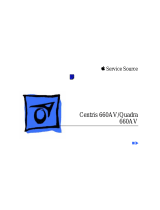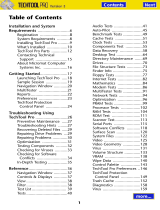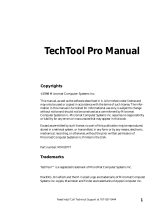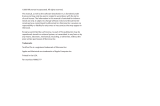Page is loading ...

Developer Note
Developer Press
© Apple Computer, Inc. 2000
Developer Note
Macintosh LC 520 Computer

Apple Computer, Inc.
© 2000, Apple Computer, Inc.
All rights reserved.
No part of this publication may be
reproduced, stored in a retrieval system,
or transmitted, in any form or by any
means, mechanical, electronic,
photocopying, recording, or otherwise,
without prior written permission of
Apple Computer, Inc. Printed in the
United States of America.
The Apple logo is a registered
trademark of Apple Computer, Inc.
Use of the “keyboard” Apple logo
(Option-Shift-K) for commercial
purposes without the prior written
consent of Apple may constitute
trademark infringement and unfair
competition in violation of federal and
state laws.
No licenses, express or implied, are
granted with respect to any of the
technology described in this book.
Apple retains all intellectual property
rights associated with the technology
described in this book. This book is
intended to assist application
developers to develop applications only
for Apple Macintosh computers.
Apple Computer, Inc.
20525 Mariani Avenue
Cupertino, CA 95014
408-996-1010
Apple, the Apple logo, APDA,
AppleLink, AppleTalk, LaserWriter,
Macintosh, and SANE are trademarks of
Apple Computer, Inc., registered in the
United States and other countries.
AppleCD, AppleColor, Apple Desktop
Bus, Apple SuperDrive, Macintosh
Centris, Macintosh Quadra,
Performa, PowerBook, QuickDraw,
and System 7.0 are trademarks of
Apple Computer, Inc.
Adobe Illustrator and PostScript are
trademarks of Adobe Systems
Incorporated, which may be registered
in certain jurisdictions.
America Online is a service mark of
Quantum Computer Services, Inc.
Classic is a registered trademark
licensed to Apple Computer, Inc.
CompuServe is a registered service
mark of CompuServe, Inc.
FrameMaker is a registered trademark
of Frame Technology Corporation.
Helvetica and Palatino are registered
trademarks of Linotype Company.
Internet is a trademark of Digital
Equipment Corporation.
ITC Zapf Dingbats is a registered
trademark of International Typeface
Corporation.
Motorola is a registered trademark of
Motorola Corporation.
NuBus is a trademark of Texas
Instruments.
Trinitron is a trademark of Sony
Corporation.
Simultaneously published in the United
States and Canada.
LIMITED WARRANTY ON MEDIA AND
REPLACEMENT
If you discover physical defects in the
manual or in the media on which a software
product is distributed, APDA will replace
the media or manual at no charge to you
provided you return the item to be replaced
with proof of purchase to APDA.
ALL IMPLIED WARRANTIES ON THIS
MANUAL, INCLUDING IMPLIED
WARRANTIES OF MERCHANTABILITY
AND FITNESS FOR A PARTICULAR
PURPOSE, ARE LIMITED IN DURATION
TO NINETY (90) DAYS FROM THE DATE
OF THE ORIGINAL RETAIL PURCHASE
OF THIS PRODUCT.
Even though Apple has reviewed this
manual, APPLE MAKES NO WARRANTY
OR REPRESENTATION, EITHER EXPRESS
OR IMPLIED, WITH RESPECT TO THIS
MANUAL, ITS QUALITY, ACCURACY,
MERCHANTABILITY, OR FITNESS FOR A
PARTICULAR PURPOSE. AS A RESULT,
THIS MANUAL IS SOLD “AS IS,” AND
YOU, THE PURCHASER, ARE ASSUMING
THE ENTIRE RISK AS TO ITS QUALITY
AND ACCURACY.
IN NO EVENT WILL APPLE BE LIABLE
FOR DIRECT, INDIRECT, SPECIAL,
INCIDENTAL, OR CONSEQUENTIAL
DAMAGES RESULTING FROM ANY
DEFECT OR INACCURACY IN THIS
MANUAL, even if advised of the possibility
of such damages.
THE WARRANTY AND REMEDIES SET
FORTH ABOVE ARE EXCLUSIVE AND
IN LIEU OF ALL OTHERS, ORAL OR
WRITTEN, EXPRESS OR IMPLIED. No
Apple dealer, agent, or employee is
authorized to make any modification,
extension, or addition to this warranty.
Some states do not allow the exclusion or
limitation of implied warranties or liability
for incidental or consequential damages, so
the above limitation or exclusion may not
apply to you. This warranty gives you
specific legal rights, and you may also have
other rights which vary from state to state.

iii
Contents
Figures and Tables vii
Preface
About This Note
ix
Contents of This Note ix
Supplemental Reference Documents x
Conventions and Abbreviations xi
Typographical Conventions xi
Standard Abbreviations xi
Chapter 1
Introduction
1
Summary of Features 2
Comparison With the Macintosh Color Classic 2
Comparison With the Macintosh LC III 3
Integrated Design 3
Front View 3
Back View 4
Access to the Logic Board 4
Built-in Color Display 4
Screen Control Pushbuttons 5
Video RAM 6
Power On and Off 6
Power Saver 7
RAM Expansion 8
RAM Configurations 8
RAM SIMM 8
PDS Expansion Slot 10
SCSI Bus 10
SCSI Connectors 10
SCSI Bus Termination 10
Comparison of SCSI Arrangements 12
Floppy Disk Drive 12
Serial I/O Ports 13
ADB Ports 15
Sound 15
Microphone 16
Sound Input Jack 16
Sound Control Pushbuttons 16
Keyboard 16

iv
Chapter 2
Architecture
19
Block Diagram 20
MC68030 Microprocessor 20
Ardbeg Custom IC 20
Ariel Custom IC 20
Combo Custom IC 22
Cuda ADB Controller 22
Sound Circuits 22
Sound Modes 22
Sample Rates 23
Address Map 23
RAM Addresses 23
Video RAM 25
Video Display Timing 25
Chapter 3
Expansion
29
Expansion Slot 30
Pin Assignments 30
Descriptions of the Signals 32
The PDS Expansion Card 34
Expansion Card Connectors 35
Address Space for the Expansion Card 35
Power for the Expansion Card 36
Chapter 4
Software
37
ROM Software 38
Unchanged Functions 38
MMU Initialization 38
Machine Identification 38
RAM Sizing and Addressing 38
One-Second Interrupt 39
Pushbutton Interrupts 39
Power Saver Software 39
Video Software 39
System Software 40
System Enabler 40
Booting From a CD-ROM 40
New Control Panels 40
Sound Control Panel 41
Screen Control Panel 42

v
The Screen Driver 42
Screen Driver Calls 42
Open 43
Control 43
Status 44
Chapter 5
Internal Storage Devices
45
Storage Device Slide-In Bays 46
Front Drive Bezel 47
Connector Adapters 48
Internal CD-ROM Drive 48
Dimensions of the CD-ROM Drive 48
Mounting Method for the CD-ROM Drive 50
Power for the CD-ROM Drive 50
Internal CD-ROM Integration 51
Appendix
AppleCD 300i Specifications
53
General Information 53
Specifications 53
Index
55
Foldouts
59


vii
Figures and Tables
Chapter 1
Introduction
1
Figure 1-1
Front view of the Macintosh LC 520 computer 4
Figure 1-2
Back view of the Macintosh LC 520 computer 5
Figure 1-3
Screen control panel 7
Figure 1-4
RAM configurations 8
Figure 1-5
RAM expansion SIMM 9
Figure 1-6
Serial port sockets 14
Table 1-1
VRAM size and number of colors 6
Table 1-2
Pin assignments for the internal and external
SCSI connectors 11
Table 1-3
Pin assignments for the internal floppy disk connector 13
Table 1-4
Serial port signals 14
Table 1-5
ADB connector pin assignments 15
Table 1-6
Reset and NMI key combinations 17
Chapter 2
Architecture
19
Figure 2-1
Block diagram 21
Figure 2-2
24-bit and 32-bit address maps 24
Figure 2-3
Standard video timing 26
Figure 2-4
Video timing for the Apple IIe card 28
Table 2-1
Video parameters for the standard display 25
Table 2-2
Video parameters for the Apple IIe display 27
Chapter 3
Expansion
29
Figure 3-1
Generating the card select signal 35
Table 3-1
Signals on the 96-pin section of the expansion connector 31
Table 3-2
Signals on the 18-pin section of the expansion connector 32
Table 3-3
Processor-direct expansion connector signal descriptions 32
Table 3-4
Expansion slot signals not connected to the MC68030 33
Table 3-5
Power available for the expansion card 36
Chapter 4
Software
37
Figure 4-1
Sound control panel 41
Figure 4-2
Sound options 41
Figure 4-3
Screen control panel 42

viii
Chapter 5
Internal Storage Devices
45
Figure 5-1
Installation of the internal CD-ROM drive 46
Figure 5-2
Front drive bezel 47
Figure 5-3
Connector locations on the CD-ROM drive 48
Figure 5-4
Connector locations on the hard disk drive 49
Figure 5-5
Dimensions of the CD-ROM drive 49
Figure 5-6
The AppleCD 300i mounted on the sled 50
Figure 5-7
Pins on the CD-ROM audio connector 51
Table 5-1
Power available for the AppleCD 300i CD-ROM drive 50
Appendix
AppleCD 300i Specifications
53
Table A-1
AppleCD 300i specifications 53

ix
PREFACE
About This Note
This developer note provides information about the Macintosh LC 520
computer, an integrated model with a built-in 14-inch color display. The
Macintosh LC 520 has about the same performance as the Macintosh LC III.
Note
While every attempt has been made to verify the accuracy of the
information presented here, it is subject to change without notice.
The primary reason for releasing this type of product information
is to provide the development community with essential product
specifications, theory, and application information for the purpose
of stimulating work on compatible third-party products.
◆
Contents of This Note 0
The information is arranged in five chapters, an Appendix, and a set of
foldouts:
■
Chapter 1, “Introduction,” gives a summary of the features and describes
the external features of the Macintosh LC 520 computer.
■
Chapter 2, “Architecture,” includes a block diagram and address maps and
describes the integrated circuits that are specific to the Macintosh LC 520
computer.
■
Chapter 3, “Expansion,” describes the single expansion slot in the
Macintosh LC 520 computer and the expansion card that plugs into it.
■
Chapter 4, “Software,” summarizes the features of the ROM software and
tells how the system software operates on the Macintosh LC 520 computer.
■
Chapter 5, “Internal Storage Devices,” is a developer guide for storage
devices to be installed inside the Macintosh LC 520 computer.
■
The Appendix gives the specifications for the AppleCD 300i, the internal
CD-ROM drive for the Macintosh LC 520 computer.
■
The foldouts provide engineering specifications and mechanical drawings
for selected parts.

x
PREFACE
Supplemental Reference Documents 0
To supplement the information in this developer note, developers should have
copies of the appropriate Apple reference books, including
Inside Macintosh
,
Volumes IV, V, and VI;
Guide to the Macintosh Family Hardware,
second edition;
and
Designing Cards and Drivers for the Macintosh Family,
third edition. These
books are available in technical bookstores and through APDA.
Because the Macintosh LC 520 computer has many of the features of the
Macintosh LC II and LC III computers, developers should also have copies of
the developer notes that describe the Macintosh LC, LC II, and LC III. Those
are, respectively:
■
Macintosh IIsi, LC, and Classic Developer Notes
, APDA catalog number
M0991LL/A
■
Macintosh Developer Note Number 1
, APDA catalog number R0451LL/A
■
Macintosh Developer Note Number 3
, APDA catalog number R0461LL/A
The developer notes are available from APDA and are also on the developer
CDs—the most recent,
Macintosh Developer Note Number 3
, has been available
since March 1993.
Note
The numbered developer notes are collections that describe several
Macintosh models. In addition to the Macintosh LC II computer,
Macintosh Developer Note Number 1
also covers the Macintosh IIvx,
the Macintosh PowerBook 145, 160, and 180, and the Macintosh
Quadra 950. Similarly,
Macintosh Developer Note Number 3
covers the
Macintosh Color Classic, the Macintosh PowerBook 165c, the Macintosh
Centris 610 and 650, and the Macintosh Quadra 800 in addition to the
Macintosh LC III.
◆
APDA is Apple’s worldwide source for over three hundred development
tools, technical resources, training products, and information for anyone
interested in developing applications on Apple platforms. Customers receive
the quarterly
APDA Tools Catalog
featuring all current versions of Apple
development tools and the most popular third-party development tools.
Ordering is easy; there are no membership fees, and application forms are not
required for most of our products. APDA offers convenient payment and
shipping options, including site licensing.

xi
PREFACE
To order products or to request a complimentary copy of the
APDA Tools
Catalog
, contact
APDA
Apple Computer, Inc.
P.O. Box 319
Buffalo, NY 14207-0319
Conventions and Abbreviations 0
This developer note uses typographical conventions and abbreviations that
are standard in Apple publications.
Typographical Conventions 0
This note uses the following typographical conventions.
New terms appear in
boldface
where they are first defined.
Computer-language text—any text that is literally the same as it appears in
computer input or output—appears in
Courier
font.
Standard Abbreviations 0
When unusual abbreviations appear in this book, the corresponding terms
are also spelled out. Standard units of measure and other widely used
abbreviations are not spelled out.
Here are the standard units of measure used this developer note:
Telephone 800-282-2732 (United States)
800-637-0029 (Canada)
716-871-6555 (International)
Fax 716-871-6511
AppleLink APDA
America Online APDA
CompuServe 76666,2405
Internet [email protected]
A amperes K 1024
dB decibels KB kilobytes
GB gigabytes kg kilograms
Hz hertz kHz kilohertz
in. inches k
Ω
kilohms
k 1000 lb. pounds

xii
PREFACE
Here are other abbreviations used in this developer note:
mA milliamperes µs microseconds
µA microamperes ns nanoseconds
MB megabytes sec. seconds
MHz megahertz V volts
mm millimeters W watts
ms milliseconds
Ω
ohms
$
n
hexadecimal value
n
AC alternating current
ADB Apple Desktop Bus
CD-ROM compact-disk read-only memory
CLUT color lookup table
EMI electromagnetic interference
FPU floating-point unit
IC integrated circuit
I/O input/output
LS low-power Schottky (used as a standard for IC
device loads)
MMU memory management unit
MOS metal-oxide semiconductor
NMI nonmaskable interrupt
PRAM parameter RAM
PWM pulse-width modulation
RAM random-access memory
RMS root-mean-square
ROM read-only memory
SANE Standard Apple Numerics Environment
SCC serial communications controller
SCSI Small Computer System Interface
SIMM single inline memory module
SWIM Super Woz Integrated Machine, a custom IC
that controls the floppy disk interface
TTL transistor-transistor logic (used as a standard
for IC device loads)
VRAM video RAM

CHAPTER 1
Introduction 1
Figure 1-0
Listing 1-0
Table 1-0

CHAPTER 1
Introduction
2
Summary of Features
The Macintosh LC 520 computer is an integrated Macintosh computer with a built-in
color display. It is a larger version of the Macintosh Color Classic
®
with many of the
performance features of the Macintosh LC III.
This chapter outlines the main features of the Macintosh LC 520 computer and describes
its appearance and external features.
Summary of Features 1
Here is a summary of the hardware features of the Macintosh LC 520 computer
(individual features are described in the sections that follow):
■
integrated design with built-in 14-inch Trinitron color display
■
Motorola MC68030 microprocessor running at 25 MHz
■
built-in video hardware using separate video RAM
■
installed RAM capacity of 4 MB, expandable to 36 MB
■
1 MB ROM in sockets; optional expansion to 2 MB
■
internal hard disk with 40 MB, 80 MB, or 160 MB capacity, using the internal SCSI
connector; external SCSI port for additional SCSI devices
■
provision for an internal CD-ROM drive or other 5.25-inch storage device
■
internal Apple SuperDrive high-density floppy disk drive with 1.4 MB capacity
■
standard Macintosh I/O ports: two ADB ports, two serial ports, sound input and
output jacks, and a SCSI port
■
built-in microphone
■
front-panel headphone jack and internal stereo speakers
■
114-pin processor-direct slot (PDS) for hardware expansion (like the PDS on the
Macintosh LC III, and compatible with the 96-pin PDS on the Macintosh Color Classic
and the Macintosh LC II)
■
power on and off from the keyboard
■
pushbuttons on the front panel to control sound volume and display intensity
■
power saver mode to allow software to turn off the display monitor when the machine
is unused for a set period of time
Comparison With the Macintosh Color Classic 1
Here is a summary of features of the Macintosh LC 520 that are different from those of
the Macintosh Color Classic:
■
larger 14-inch Trinitron color display
■
microprocessor running at 25 MHz instead of 16 MHz; data bus 32 bits wide instead of
16 bits.

CHAPTER 1
Introduction
Integrated Design
3
■
integrated case larger than that of the Macintosh Color Classic
■
RAM expandable to 36 MB instead of 10 MB
■
two internal speakers for stereo sound output
■
two sound output jacks, one in front, one in back
■
provision for an internal CD-ROM drive
■
extended processor-direct slot (PDS) for hardware expansion
Comparison With the Macintosh LC III 1
The Macintosh LC 520 computer combines the integrated design of the Macintosh Color
Classic with many of the functions and capabilities of the Macintosh LC III. Here is a
summary of features of the Macintosh LC 520 that are different from those of the
Macintosh LC III:
■
integrated design with a built-in 14-inch Trinitron color display
■
front-panel pushbuttons to control sound level and screen intensity
■
built-in microphone
■
stereo sound output, with built-in stereo speakers
■
two sound output jacks, one in front, one in back
■
provision for an internal CD-ROM drive
■
expansion socket for the system ROM
■
no external video connector
■
a different ADB controller IC (the Cuda)
Integrated Design 1
The Macintosh LC 520 computer has an integrated design similar to that of the Macintosh
Color Classic.
Front View 1
Figure 1-1 on page 4 shows the front of the Macintosh LC 520 computer, including the
display screen, the floppy disk slot, the CD-ROM slot, the front-panel headphone jack,
and the pushbuttons that control the screen intensity and sound level.

CHAPTER 1
Introduction
4
Built-in Color Display
Figure 1-1
Front view of the Macintosh LC 520 computer
Back View 1
Figure 1-2 shows the back of the Macintosh LC 520 computer. The master power switch is
located just beneath the fan grille. The external connectors are located in a row across the
lower part of the back.
Access to the Logic Board 1
Just above the row of I/O connectors on the back of the computer are two projecting tabs.
By pushing down on the tabs, the user can remove the connector cover and gain access to
the main logic board. The logic board has a custom connector that plugs into a socket at
the front so that the user can remove the board from the case by pulling it out the back.
Once the board has been removed, the user can add expansion RAM or plug in an
expansion card, as described in later sections of this note.
Built-in Color Display 1
The Macintosh LC 520 computer has a built-in color display with a 14-inch Trinitron
monitor. Like the video interface in the Macintosh Color Classic, the video interface
in the Macintosh LC 520 computer uses separate VRAM for the screen buffer. The
Macintosh LC 520 does not have an external video connector.
Built-in microphone
Color display
CD-ROM drive (optional)
Floppy disk drive
Stereo speakers
Screen control buttons
Headphone jack
Power-on light
Sound control buttons

CHAPTER 1
Introduction
Built-in Color Display 5
Figure 1-2 Back view of the Macintosh LC 520 computer
The display screen in the Macintosh LC 520 computer displays the same amount of
information as the Macintosh 14-inch color display: 640 by 480 pixels.
Note
The Macintosh LC 520 computer also provides a 16-color,
560-by-384-pixel display mode when an Apple IIe Card is
installed in the expansion slot. ◆
Screen Control Pushbuttons 1
The Macintosh LC 520 computer has two pairs of pushbuttons on the front panel. The
pair on the left controls the intensity of the screen: pressing the top button causes the
intensity to increase, and pressing the bottom button causes the intensity to decrease. If
the user holds down a button, the intensity continues to increase (or decrease) until it
reaches a maximum (or minimum). (The pair of pushbuttons on the right controls the
sound level.)
Note
The user can also control the screen brightness and contrast by means of
the Screen control panel, described in the section “Screen Control Panel”
on page 42. ◆
Power switch
Power connector
SCSI port
Expansion card access
Printer port
Modem port
ADB ports
Sound output jack
Sound input jack

CHAPTER 1
Introduction
6Power On and Off
Video RAM 1
The Macintosh LC 520 computer comes with 512 KB of VRAM and a socket for a SIMM
with an additional 256 KB of VRAM. The VRAM expansion SIMM is the same 68-pin
SIMM used with the Macintosh LC III and Macintosh Quadra computers. It requires
VRAM devices with access times of 80 ns or less.
The basic 512 KB VRAM provides up to 8 bits per pixel; the screen displays up to 256
colors, software-selectable from a range of 16 million. With the VRAM SIMM installed,
the Macintosh LC 520 has 768 KB of VRAM, allowing it to display up to 16 bits per pixel,
which provides 32,768 colors. If the VRAM SIMM has been installed, the user can set
the display to 16 bits per pixel by opening the Monitors control panel and choosing
Thousands.
Table 1-1 lists the bits per pixel and numbers of colors available for the different sizes
of VRAM.
Power On and Off 1
The master power switch on the back of the computer must be in the On position for the
computer to operate. As long as the master power switch is in the On position, the user
can turn the power off and on by pressing the power key on the keyboard.
Note
If you plan to leave the computer turned off for an extended period of
time, you should flip the master power switch to the Off position. ◆
If the user attempts to turn off the computer—using either the power key or the Shut
Down menu item—while files are still open, the system displays an alert box warning the
user that files are open and should be closed to avoid loss of data. If the user turns off the
master power switch while the computer is operating, the computer shuts off
immediately, without performing the safe shutdown.
Table 1-1 VRAM size and number of colors
VRAM size Bits per pixel Number of colors
512 KB 1, 2, 4, or 8 2, 4, 16, or 256
768 KB 1, 2, 4, 8, or 16 2, 4, 16, 256, or 32,768
(only 15 bits are used)

CHAPTER 1
Introduction
Power Saver 7
Power Saver 1
The power saver is an optional feature that automatically turns off the display whenever
the Macintosh LC 520 computer is turned on but is not used for more than a set period of
time. The user selects the power saver and sets the length of time before the screen turns
off by adjusting the slider in the Screen control panel, shown in Figure 1-3. After the
power saver has turned the display off, the software turns the display back on again
whenever the user moves the mouse or presses a key on the keyboard.
Figure 1-3 Screen control panel
Note
It may take up to several seconds for the screen display to reappear.
To let the user know that it has responded to the user’s action, the
computer emits a series of beeps while this is happening. ◆

CHAPTER 1
Introduction
8RAM Expansion
RAM Expansion 1
The Macintosh LC 520 computer comes with 4 MB of RAM built in. By installing a SIMM,
the user can expand the RAM up to a maximum of 36 MB.
RAM Configurations 1
Figure 1-4 shows the RAM configurations for different amounts of RAM. For more
information, see the section “RAM Addresses” on page 23.
Figure 1-4 RAM configurations
RAM SIMM 1
The Macintosh LC 520 computer accepts one 72-pin RAM SIMM, illustrated in
Figure 1-5. The access time of the RAM must be 80 ns or less. The RAM SIMM can
contain 1 MB, 2 MB, 4 MB, 8 MB, 16 MB, or 32 MB of additional RAM.
Note
The SIMM used in the Macintosh LC 520 computer is not the same as the
30-pin SIMMs used on some other Macintosh computers. ◆
4 MB 5 MB 6 MB 8 MB 12 MB 20 MB 36 MB
/







